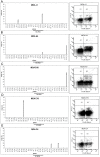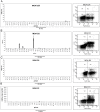In Vitro Variant Surface Antigen Expression in Plasmodium falciparum Parasites from a Semi-Immune Individual Is Not Correlated with Var Gene Transcription
- PMID: 27907004
- PMCID: PMC5132323
- DOI: 10.1371/journal.pone.0166135
In Vitro Variant Surface Antigen Expression in Plasmodium falciparum Parasites from a Semi-Immune Individual Is Not Correlated with Var Gene Transcription
Abstract
Plasmodium falciparum erythrocyte membrane protein 1 (PfEMP1) is considered to be the main variant surface antigen (VSA) of Plasmodium falciparum and is mainly localized on electron-dense knobs in the membrane of the infected erythrocyte. Switches in PfEMP1 expression provide the basis for antigenic variation and are thought to be critical for parasite persistence during chronic infections. Recently, strain transcending anti-PfEMP1 immunity has been shown to develop early in life, challenging the role of PfEMP1 in antigenic variation during chronic infections. In this work we investigate how P. falciparum achieves persistence during a chronic asymptomatic infection. The infected individual (MOA) was parasitemic for 42 days and multilocus var gene genotyping showed persistence of the same parasite population throughout the infection. Parasites from the beginning of the infection were adapted to tissue culture and cloned by limiting dilution. Flow cytometry using convalescent serum detected a variable surface recognition signal on isogenic clonal parasites. Quantitative real-time PCR with a field isolate specific var gene primer set showed that the surface recognition signal was not correlated with transcription of individual var genes. Strain transcending anti-PfEMP1 immunity of the convalescent serum was demonstrated with CD36 selected and PfEMP1 knock-down NF54 clones. In contrast, knock-down of PfEMP1 did not have an effect on the antibody recognition signal in MOA clones. Trypsinisation of the membrane surface proteins abolished the surface recognition signal and immune electron microscopy revealed that antibodies from the convalescent serum bound to membrane areas without knobs and with knobs. Together the data indicate that PfEMP1 is not the main variable surface antigen during a chronic infection and suggest a role for trypsin sensitive non-PfEMP1 VSAs for parasite persistence in chronic infections.
Conflict of interest statement
The authors have declared that no competing interests exist.
Figures








References
-
- WHO | World Malaria Report 2014. In: WHO [Internet]. [cited 1 Dec 2015]. http://www.who.int/malaria/publications/world_malaria_report_2014/en/
-
- Cohen S, McGREGOR IA, Carrington S. Gamma-globulin and acquired immunity to human malaria. Nature. 1961;192: 733–737. - PubMed
-
- Edozien JC, Gilles HM, Udeozo IOK. ADULT AND CORD-BLOOD GAMMA-GLOBULIN AND IMMUNITY TO MALARIA IN NIGERIANS. The Lancet. 1962;280: 951–955.
-
- Marsh K, Howard RJ. Antigens induced on erythrocytes by P. falciparum: expression of diverse and conserved determinants. Science. 1986;231: 150–153. - PubMed
MeSH terms
Substances
LinkOut - more resources
Full Text Sources
Other Literature Sources
Research Materials

